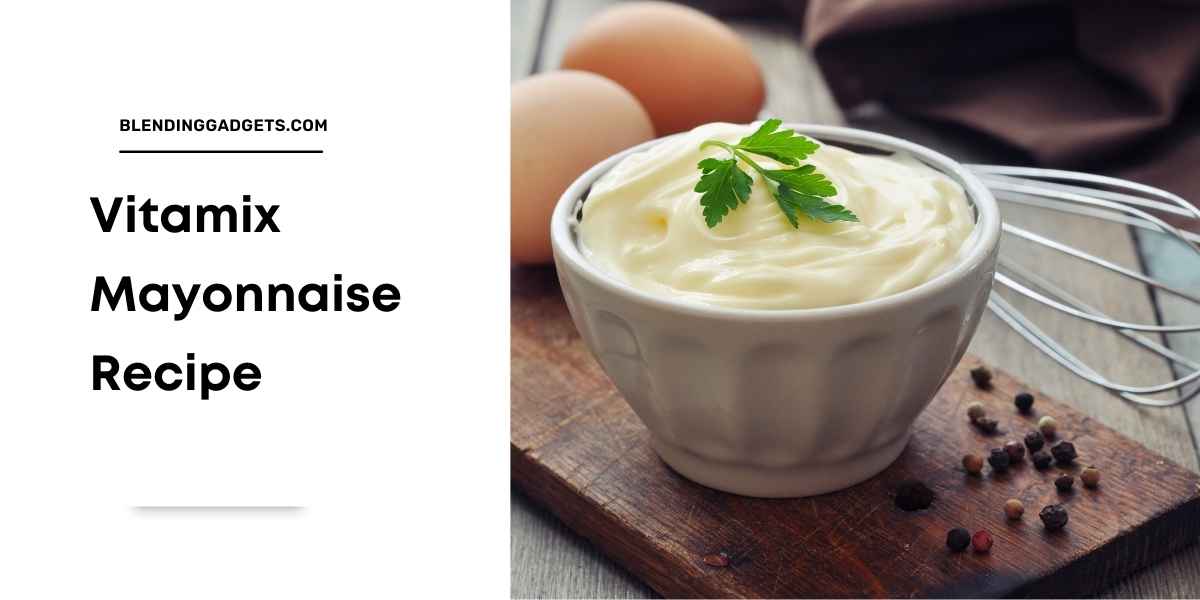Making mayonnaise in a Vitamix blender is easy. All you need to do is add the ingredients and let the machine do all of the work for you!
The most important thing to remember when making homemade mayo is that it’s not about how creamy or thick your mixture looks, but rather how well it emulsifies.
A good way to test this is by dipping a spoon into your mixture and seeing if there are any drops left on the surface. If so, then you still have more whipping cream or olive oil that needs to be added in order for everything to mix together nicely.
If you follow these directions carefully, I guarantee that after one taste of this perfect condiment, you will never want to buy a jar of store-bought mayo ever again.

Why Make Homemade Mayonnaise In A Vitamix Blender?
Besides the fact that it’s healthier, cheaper, and more flavorful than store-bought mayo, making your own also allows you to experiment with different flavors.
For instance, if you prefer garlic or chipotle peppers in your mayonnaise, you can easily add them to this mixture.
The Vitamix blender is perfect for making homemade mayonnaise because it has a low-profile container which makes getting all of the ingredients into the bottom corner easy. Thus ensuring that everything gets blended together without being left behind clumps of unmixed condiments.
You don’t need any fancy ingredients to make mayonnaise either.
The basic ingredients are olive oil (or another type of vegetable oil), egg yolks, lemon juice, and mustard.
However, you can also add a variety of flavors to the mixture by adding Dijon mustard, garlic cloves, or dried herbs.
You can even try flavored oils such as avocado oil for a burst of flavor.
How To Make Mayonnaise In A Vitamix Blender?
Ingredients
- 1 egg yolk
- 1 tbsp lemon juice, juiced
- 1 tsp dry mustard powder Don’t forget you can always add in any other flavors or spices to change the taste of your homemade mayonnaise!
- ½ cup vegetable oil (or olive oil) ½ tsp salt ¼ tsp black pepper
Method
Add all ingredients to the Vitamix blender.
Make sure that the lid is on tight and then blend for 20 seconds at high speed.
You will know that it’s time to stop when there are no more drops from your spatula coating the sides of your jar.
If you find that your mayo still has tiny drops and is not fully smooth and creamy yet, you can give it another quick burst of 10 seconds.
Transfer the mayonnaise to a jar with a lid and store it in your refrigerator.
If you wish to make more batches of this condiment, we recommend making one large batch as otherwise measuring out each ingredient may be difficult.
You can always freeze whatever leftover mayo that you have for later use if necessary!
Editor’s note: For those wanting an alternative mayo recipe without mustard or pepper, simply omit those ingredients from the list! Also, include substitutes if people don”t have dry mustard powder or fresh lemon juice on hand!
Vitamix Cashew Mayonnaise Recipe
Ingredients
- ½ cup raw cashews soaked for 30 minutes and drained
- 1 ½ cups water
- 3 tbsp lemon juice
- 2 tsp dry mustard powder (If you don’t have dry mustard then use 2 tbsp of prepared mustard. If you want it to taste like a classic American mayo then omit!)
- ¾ tsp salt (you can also use sea salt)
Method
Place all ingredients in a Vitamix container and secure the lid.
Turn on low speed and gradually increase to high; blend for 30 seconds or until smooth and creamy.
If the mixture is too thick, add more water as needed. This recipe will last 7 days stored in an airtight container in the refrigerator. It also freezes nicely!
How To Use Mayonnaise Prepared Using This Recipe
Mayonnaise can be used in many dishes like other condiments like ketchup or mustard.
Mayonnaise is delicious when spread onto sandwiches, wraps, or even burgers; it also works well as a dipping sauce for snacks like fries or spring rolls.
Mayonnaise can work great as an ingredient in pasta salad and potato salads too!
Try mixing up the flavors of your mayo by adding finely chopped herbs like parsley, basil, or chives to create different variations!
You could try experimenting with adding garlic powders, cayenne pepper, smoked paprika, etc. for added taste!
Frequently Asked Questions
What Is Mayonnaise Made Out Of?
Typically, mayonnaise brands use eggs, vegetable oil, sugar/honey, distilled vinegar, salt, and lemon juice to make their condiment. However, a few recipes do exist which use yogurt or silken tofu in place of eggs.
Is Mayonnaise Healthy For You?
People often worry that mayonnaise will be bad for their health because it’s rich in fat from the oils used in its preparation.
Although there are some variations of this condiment that contain unhealthy ingredients such as added sugars or trans fats too!
In general, though most restaurant-made and store-bought kinds of mayonnaise are relatively healthy – they usually contain around 70-90 calories per serving and a small number of healthy fats.
Is Mayonnaise Gluten-Free?
Typically, brands that make mayonnaise use ingredients that contain gluten in some form or another, so it would be advised to check the label to confirm whether your condiment contains any traces of this substance.
Can You Eat Mayonnaise If You Have A Nut Allergy?
Mayonnaise is traditionally made with eggs that are derived from chickens so most varieties of mayo will definitely not be suitable for people who have allergies related to nuts. However, there are non-egg versions available too!
How Long Does Homemade Mayo Last?
Typically, store-bought or restaurant-made types of this condiment can stay fresh in the refrigerator for up to 3 months after you make them.
If you store your mayonnaise in a tightly sealed container, it can also stay fresh in the freezer for around 6 months.
How Do You Get Lumpy Mayonnaise?
Mayo starts becoming thick and lumpy when water separates from the oil or if sugar crystallizes which causes it to clump together!
The trick is to use room temperature ingredients that aren’t too hot and pour very slowly: if you add everything quickly, then this usually leads to poor results and will not create a smooth mixture at all!
Cold eggs mixed with cold oil will cause your product to be firm and unspreadable once refrigerated whereas cold eggs mixed with warm oil or salt will cause your product to be overly runny.
How Much Oil Should I Use To Make Mayonnaise?
Typically, you want to use around ¾ cup of oil (a mixture of two-thirds vegetable oil and one-third olive oil works well but you can experiment with different ratios!) plus 2 eggs per cup of ingredients!
Adding too much oil will result in an oily end product that is difficult to spread onto sandwiches or burgers while adding too little will not emulsify successfully into a smooth condiment!
It’s best to start out by adding the least amount of ingredients for flavor and adjusting after it goes bad so you can understand how long it lasts in your refrigerator!
How Do I Prevent My Mayonnaise From Becoming Too Runny?
You can use a few different tricks to achieve this: adding salt (¼ tsp per cup of oil and 2 eggs) will make your product thick and stable even if you refrigerate it for weeks!
If you’re making a flavored mayo, try adding the ingredients that help stabilize it such as mustard or tomatoes – both can help prevent water from coming out of suspension in the emulsion.
Certain kinds of acid like lemon juice also act as emulsifying agents, especially when used in conjunction with eggs!
How Do I Get My Mayonnaise To Stay On Sandwiches Better?
One trick is to add some kind of acidic ingredient like lemon juice or white wine vinegar which helps bind everything together while also preventing water from separating out of the mixture!
Additionally, you can just add a little bit of sugar to your mayonnaise which will help stabilize it even more – some cultures have been using this trick for centuries with excellent results!
When Should I Throw Away Mayonnaise?
If you notice that your condiment is starting to look watery around the edges, this means that it has already separated out too much oil and will need to be thrown out soon.
If it starts looking lumpy or if the color changes drastically, then toss it!
Mayonnaise’s best-by date can vary depending on how you store it but for most brands, up to 3 months in the refrigerator is usually safe!
We hope you found this article helpful when making the perfect homemade mayonnaise!
Please feel free to experiment with different ingredients and ratios so you can make the perfect mayo for your cooking needs.
Related Posts




